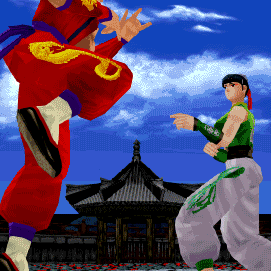Dead
or Alive

REVIEW: The
first iteration of Dead or Alive was released in arcades in 1996. The 3D
fighter utilized Sega's Model 2 arcade board and was the first time Sega licensed their
hardware to a third-party-company (in this case, Tecmo). At first glance, DOA
definitely resembled Sega's
Virtua
Fighter 2 in more ways than one, presenting a roster of 8 selectable martial artists.
Dead or
Alive was later ported to the Sega Saturn only in Japan, and in 1998, a
version of DOA hit the Sony PlayStation. The PS1 version featured many differences
over the other versions, including
reworked graphics, new moves and also a TON of unlockables: 84
character costumes, to be exact!
|

|
|
DOA
began with only
3 females... boy, did that change.
|
At the time of its debut, DOA's gameplay
engine is definitely most comparable to Sega's Virtua Fighter series,
utilizing only 3 buttons (punch, kick
and hold). However, DOA is a considerably faster game than Virtua Fighter and
relies more on simplistic commands
and reaction time. DOA's gameplay system features a reversal system,
enabling players to easily counter their opponent's moves (later to become a
trademark gameplay element of the series). DOA's
countering system was the first to utilize different
commands that corresponded to each type of attack.
|


|
|
DOA didn't
invent the breast jiggle... but the series did become known for it.
|
The other unique (and
somewhat odd) aspect gameplay element introduced by DOA is the "Danger Zone," which
surround the outer edges of the fighting arena. When a character comes in
contact with the danger zone, they are sent flying into the air (creating an
easy combo opportunity for skilled players). As a 3D fighting game fan, I'd say the main
flaw of DOA's gameplay is the lack of a sidestep mechanic (which was
becoming a staple feature in other 3D fighters).
|

|
|
At
a glance, DOA could be confused with Virtua Fighter 2.
|
Dead or Alive quickly became known for
its silly animation of 'breasts' on the
female characters, which are comically large, and slowly bounce up and
down whilst the character was fighting. As the first game to really incorporate
this "jiggle" effect, one can't admit that it was pretty entertaining
for the time.  As you probably know, this would later become an infamous trademark of the DOA
series (and only became more and more exaggerated). Overall, the character designs of the original DOA weren't terrible, but definitely
lacked originality and excitement in some areas. In a nutshell, character personalities and
overall fighting styles were a bit dry... giving me a "been there, done
that (and already done it better)" sort of feeling.
As you probably know, this would later become an infamous trademark of the DOA
series (and only became more and more exaggerated). Overall, the character designs of the original DOA weren't terrible, but definitely
lacked originality and excitement in some areas. In a nutshell, character personalities and
overall fighting styles were a bit dry... giving me a "been there, done
that (and already done it better)" sort of feeling.
|

|
|
Part
of DOA1's intro
featuring Lei Fang & Jann Lee.
|
|
|

| Page Updated: |
July
18th, 2024 |
| Developer(s): |
Team Ninja |
| Publisher(s): |
Tecmo |
| Designer(s): |
Tomonobu Itagaki |
| Platform(s): |
Arcade, Sega Saturn,
PlayStation
|
| Release Date(s): |
1996
Arcade
Oct. 9th, 1997
 Saturn Saturn
Mar. 12th, 1998
 PS1 PS1
Mar. 31st, 1998
 PS1 PS1 |
| Characters: |
Kasumi, Ayane, Lei
Fang, Tina Armstrong,
Bass Armstrong, Zack,
Hayabusa,
Gen
Fu, Jann Lee, Bayman,
Raidou |
|
|
|
Featured Video:
|
|
|
| Related Games: |
Dead
or Alive 2, Dead or Alive 2: Hardcore, Dead
or Alive 3, Dead or Alive 4, Dead
or Alive 5, Dead or Alive 5: Ultimate, Dead
or Alive: Dimensions,
Dead or Alive 6, Virtua Fighter, Virtua
Fighter Remix, Virtua
Fighter 2, Fighters Megamix, Last
Bronx, Mace: The Dark Age, Star
Gladiator, Toshinden 2, Soul
Blade, Tekken 3, Tobal
No. 1 |
|

|
|
Gameplay
Engine
|
7.5 / 10
|
|
Story
/ Theme
|
6.0 / 10
|
|
Overall
Graphics
|
9.0 / 10
|
|
Animation
|
7.5 / 10
|
|
Music
/ Sound Effects
|
4.5 / 10
|
|
Innovation
|
7.0 / 10
|
|
Art Direction
|
5.0 / 10
|
|
Customization
|
9.0 / 10
|
|
Options / Extras
|
8.5 / 10
|
|
Intro / Presentation
|
6.5 / 10
|
|
Replayability / Fun
|
7.0 / 10
|
|
"Ouch" Factor
|
7.5 / 10
|
|
Characters
|
6.0 / 10
|
|
BOTTOM LINE
|
7.2
/
10
|
|
Review based on PS1 version
|
|
| Final
Words: |
Team Ninja made
a statement in the fighting genre with the first DOA, giving 3D
fighting game fans an interesting alternative to the likes of VF, Tekken and Soul
Blade to name a few. The PS1 version of DOA was pretty fun for a
while, but overall,
didn't quite have the lasting appeal that other fighting games had (in my
opinion).
The unlockable costumes definitely added a ton of replay value at least... no doubt "84
character costumes" left an imprint in the minds of many players. Other
than that, DOA1 was lacking in other ways. For one, the music & sound
effects may have been Dead or Alive's biggest flaw... I remember the
music particularly boring and even annoying at times. However, DOA was a
stepping stone in what would become one of the major titles in the next
generation of
3D fighters.
~TFG Webmaster | @Fighters_Gen
|
|
|
|
|
|
|
|
|
|
|
|
|
|
|